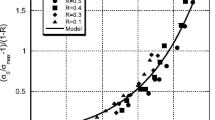Abstract
New experimental results have made necessary the reformulation of the theory for compressive strength. The new theory is based on the precept that a number of different mechanisms can cause composite failure. The active one in a particular situation is that which gives the lowest failure stress. Thus composite strength can be dominated by fibre strength when the fibres are ductile, or controlled by matrix yielding when the matrix is soft. Lack of linearity in the fibres has a very important effect also, as does the adhesion between the matrix and the fibres. Modulus is affected as well as strength. Governing equations are developed for six different mechanisms and the agreement with experiment is very good. It is concluded that to make composites with good compressive properties the fibres should be hard, as straight as possible and well bonded to the matrix. The matrix should have a high yield stress, tensile strength and compressive strength. Hybridization is useful to improve the compressive strength of Kevlar composites, but should be avoided with brittle fibre systems due to unfavourable “hybrid effects”.
Similar content being viewed by others
References
B. W. Rosen, “Composite Materials”, (American Society for Metals, Metals Park, Ohio, 1964) Ch. 3.
A. Kelly, “Strong Solids”, 2nd edn. (Clarendon Press, Oxford, 1973). 171.
J. Hayashi andK. Koyama,Soc. Mater Sci. Japan 5, (1974) 104.
M. R. Piggott andB. Harris,J. Mater Sci. 15, (1980) 2523.
E. Moncunil De Ferran andB. Harris,J. Comp. Mater. 4 (1960) 62.
P. Wilde andM. R. Piggott,J. Mater Sci. 15, (1980) 2811.
G. M. Martinez, D. M. R. Bainbridge, M. R. Piggot andB. Harris,ibid. 16 (1981) 2831.
C. R. Chaplin,ibid. 12, (1977) 347.
D. G. Swift,J. Phys. D. 8 (1975) 223.
J. Ostrowski, G. Will andM. R. Piggott, unpublished work.
M. R. Piggott, “Load Bearing Fibre Composites” Pergamon, Oxford, 1980) p. 85.
N. L. Hancox,J. Mater Sci. 10 (1975) 234.
M. R. Piggott andB. Harris,J. Mater Sci. 16 (1981) 687.
Author information
Authors and Affiliations
Rights and permissions
About this article
Cite this article
Piggott, M.R. A theoretical framework for the compressive properties of aligned fibre composites. J Mater Sci 16, 2837–2845 (1981). https://doi.org/10.1007/BF02402848
Received:
Accepted:
Issue Date:
DOI: https://doi.org/10.1007/BF02402848




